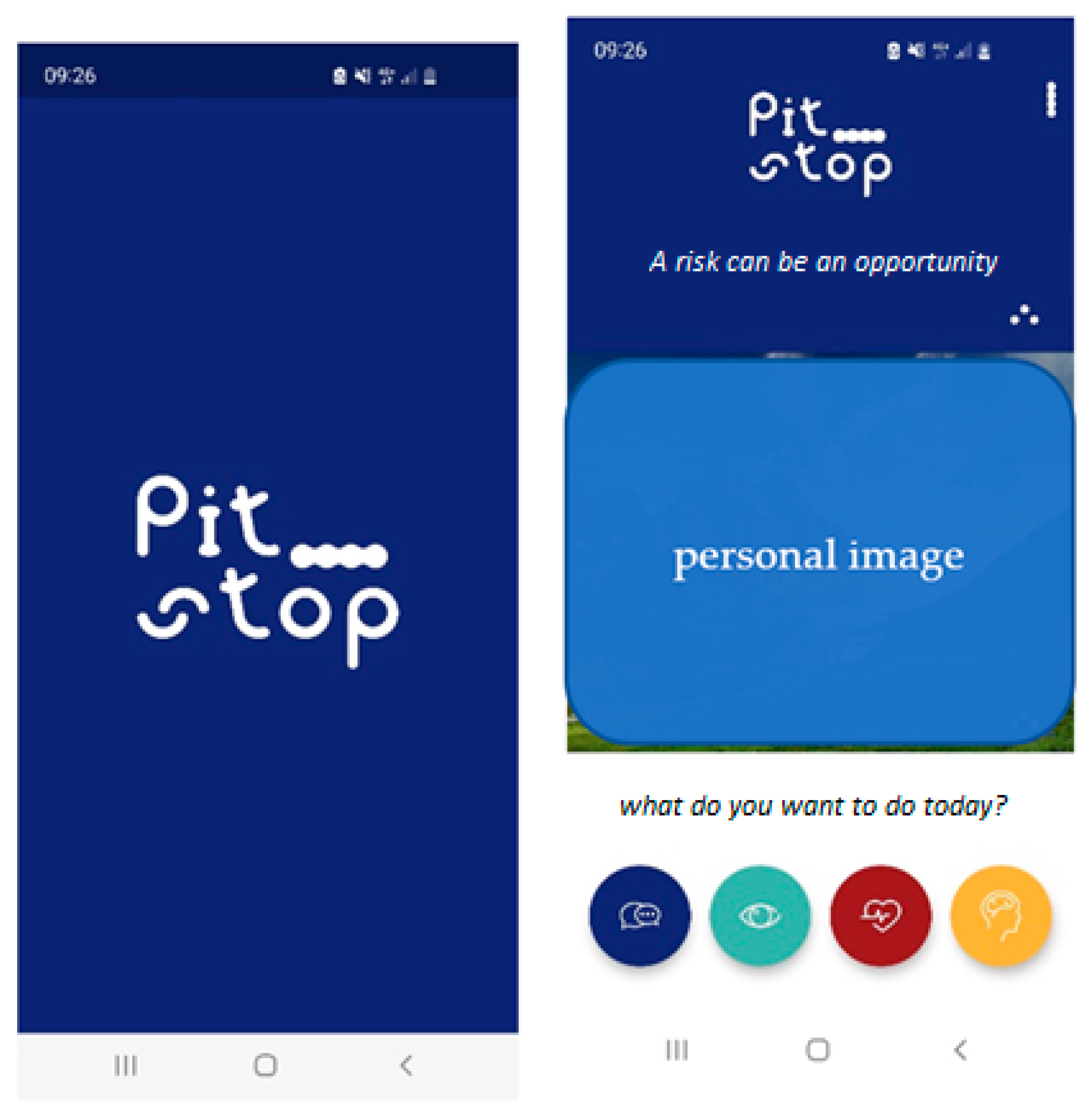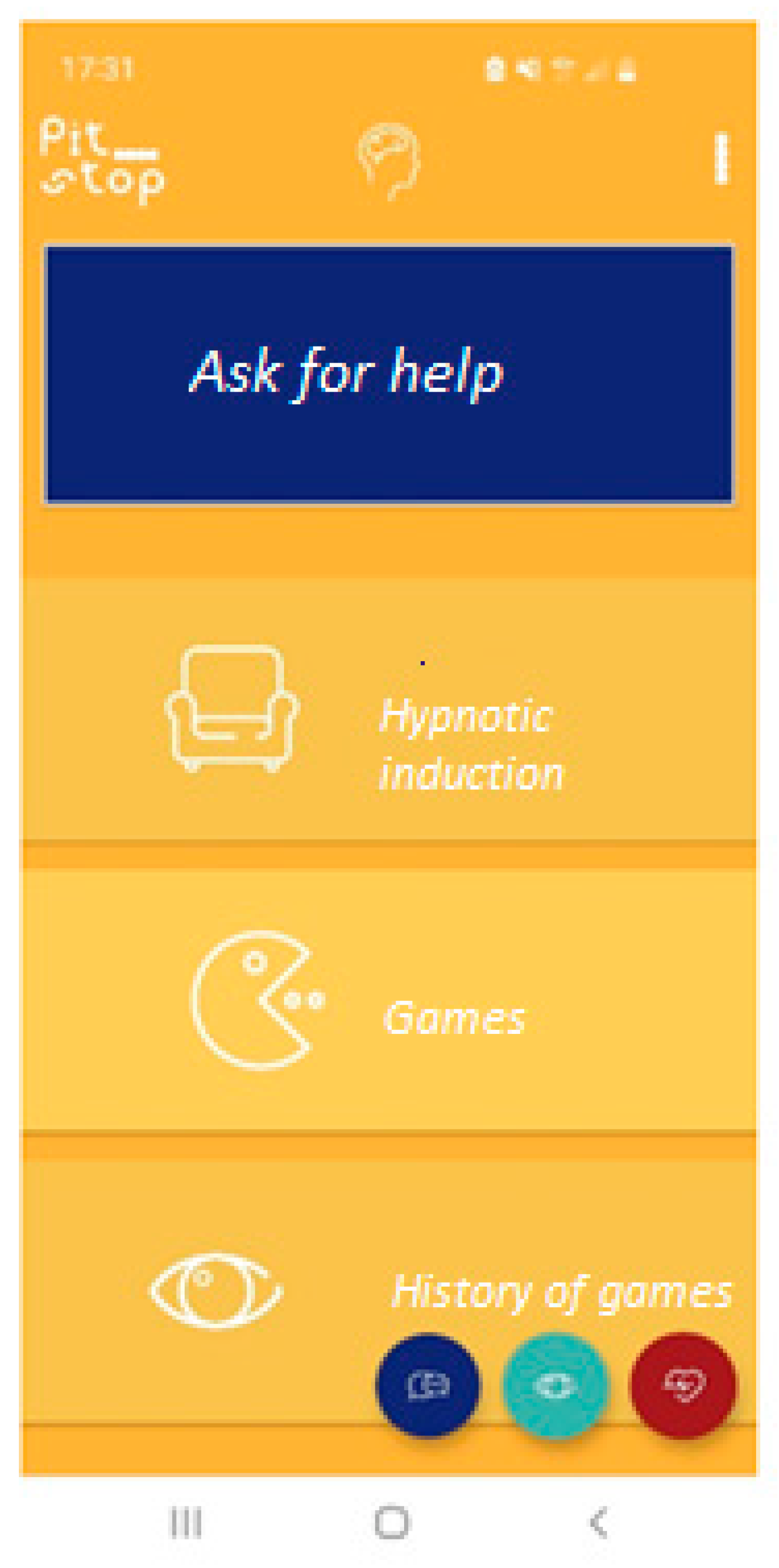Dealing with Loved Ones’ Addiction: Development of an App to Cope with Caregivers’ Stress
Abstract
1. Introduction
2. Materials and Methods
2.1. Recruitment and Participants
2.2. Procedure
3. Results
3.1. App Design and Functionality
3.1.1. Information Section
3.1.2. Self-Care Section
3.1.3. “How to: Stress Reduction” Section
3.1.4. Chat Section
3.2. Usability Testing
4. Discussion
5. Conclusions
Author Contributions
Funding
Institutional Review Board Statement
Informed Consent Statement
Data Availability Statement
Conflicts of Interest
References
- Lander, L.; Howsare, J.; Byrne, M. The impact of substance use disorders on families and children: From theory to practice. Soc. Work. Public Health 2013, 28, 194–205. [Google Scholar] [CrossRef]
- Park, J.Y.E.; Tracy, C.S.; Gray, C.S. Mobile phone apps for family caregivers: A scoping review and qualitative content analysis. Digit. Health 2022, 8, 20552076221076672. [Google Scholar] [CrossRef]
- Ploeg, J.; Markle-Reid, M.; Valaitis, R.; McAiney, C.; Duggleby, W.; Bartholomew, A.; Sherifali, D. Web-based interventions to improve mental health, general caregiving outcomes. Research 2007, 16, 29–43. [Google Scholar]
- Lu, Y.F.; Wykle, M. Relationships between caregiver stress and self-care behaviors in response to symptoms. Clin. Nurs. Res. 2007, 16, 29–43. [Google Scholar] [CrossRef]
- Yu, Y.; Liu, Z.W.; Li, T.X.; Zhou, W.; Xi, S.J.; Xiao, S.Y.; Tebes, J.K. A comparison of psychometric properties of two common measures of caregiving burden: The family burden interview schedule (FBIS-24) and the Zarit caregiver burden interview (ZBI-22). Health Qual. Life Outcomes 2020, 18, 1–9. [Google Scholar] [CrossRef]
- Cooper, C.; Blanchard, M.; Selwood, A.; Walker, Z.; Livingston, G. Family carers’ distress and abusive behaviour: Longitudinal study. Br. J. Psychiatry 2010, 196, 480–485. [Google Scholar] [CrossRef]
- Sklenarova, H.; Krümpelmann, A.; Haun, M.W.; Friederich, H.C.; Huber, J.; Thomas, M.; Hartmann, M. When do we need to care about the caregiver? Supportive care needs, anxiety, and depression among informal caregivers of patients with cancer and cancer survivors. Cancer 2005, 121, 1513–1519. [Google Scholar] [CrossRef]
- Hasan, A.A.; Alasmee, N. Evaluation of the impact of a self-stigma reduction programme on psychosocial outcomes among people with schizophrenia spectrum disorder. J. Ment. Health 2022, 31, 83–91. [Google Scholar] [CrossRef]
- Mohamed Ali, N.; Sayed Mohamed, H. Minimizing Burdens and Enhancing Quality of Life Among Family Caregivers of Patients with Substance Misuse Disorders. Egypt. J. Health Care 2022, 13, 502–516. [Google Scholar] [CrossRef]
- Arnaud, N.; Baldus, C.; Laurenz, L.J.; Bröning, S.; Brandt, M.; Kunze, S.; Thomasius, R. Does a mindfulness-augmented version of the German Strengthening Families Program reduce substance use in adolescents? Study protocol for a randomized controlled trial. Trials 2020, 21, 1–15. [Google Scholar] [CrossRef]
- Kumar, P.; Chaudhary, R.; Bhalla, J.K.; Mishra, B.P. Comparison of psychiatric morbidity and quality of life among caregivers of substance abusers. Ann. Indian Psychiatry 2021, 5, 164. [Google Scholar]
- Biegel, D.E.; Katz-Saltzman, S.; Meeks, D.; Brown, S.; Tracy, E.M. Predictors of depressive symptomatology in family caregivers of women with substance use disorders or co-occurring substance use and mental disorders. J. Fam. Soc. Work 2010, 13, 25–44. [Google Scholar] [CrossRef]
- Barati, M.; Bandehelahi, K.; Nopasandasil, T.; Jormand, H.; Keshavarzi, A. Quality of life and its related factors in women with substance use disorders referring to substance abuse treatment centers. BMC Women’s Health 2021, 21, 1–7. [Google Scholar] [CrossRef]
- Ormel, I.; Law, S.; Abbott, C.; Yaffe, M.; Saint-Cyr, M.; Kuluski, K.; Macaulay, A.C. When one is sick and two need help: Caregivers’ perspectives on the negative consequences of caring. PXJ 2017, 4, 66–78. [Google Scholar] [CrossRef]
- Mancheri, H.; Sabzi, Z.; Alavi, M.; Vakili, M.A.; Maghsoudi, J. The Quality of Life of Women with Addicted Husbands and its Related Factors in Gorgan, Iran. J. Res. Dev. Nurs. Midwifery 2021, 18, 9–12. [Google Scholar]
- World Health Organization. mHealth: New Horizons for Health through Mobile Technologies. 2011. Available online: http://www.who.int/goe/publications/goe_mhealth_web.pdf (accessed on 17 November 2021).
- Bonfiglio, N.S.; Mascia, M.L.; Cataudella, S.; Penna, M.P. Digital help for substance users (SU): A systematic review. Int. J. Environ. Res. Public Health 2022, 19, 11309. [Google Scholar] [CrossRef]
- Bonfiglio, N.S.; Mascia, M.L.; Penna, M.P. Digital Treatment Paths for Substance Use Disorders (SUDs). Int. J. Environ. Res. Public Health 2022, 19, 7322. [Google Scholar] [CrossRef]
- Drew, D.A.; Nguyen, L.H.; Steves, C.J.; Menni, C.; Freydin, M.; Varsavsky, T. Rapid implementation of mobile technology for real-time epidemiology of COVID-19. Science 2020, 368, 1362–1367. [Google Scholar] [CrossRef]
- Ting, D.S.W.; Carin, L.; Dzau, V.; Wong, T.Y. Digital technology and COVID-19. Nat. Med. 2020, 26, 459–461. [Google Scholar] [CrossRef]
- Grossman, M.R.; Zak, D.K.; Zelinski, E.M. Mobile apps for caregivers of older adults: Quantitative content analysis. JMIR Mhealth Uhealth 2018, 6, e162. [Google Scholar] [CrossRef]
- Zulman, D.M.; Piette, J.D.; Jenchura, E.C.; Asch, S.M.; Rosland, A.M. Facilitating out-of-home caregiving through health information technology: Survey of informal caregivers’ current practices, interests, and perceived barriers. J. Med. Int. Res. 2013, 15, e123. [Google Scholar] [CrossRef]
- Smith, J.A. Qualitative Psychology: A Practical Guide to Research Method; Sage: London, UK, 2015. [Google Scholar]
- Zhou, L.; Bao, J.; Setiawan, I.M.A.; Saptono, A.; Parmanto, B. The mHealth App Usability Questionnaire (MAUQ): Development and validation study. JMIR Mhealth Uhealth 2019, 7, e11500. [Google Scholar] [CrossRef]
- van Gemert-Pijnen, J.E.; Nijland, N.; van Limburg, M.; Ossebaard, H.C.; Kelders, S.M.; Eysenbach, G.; Seydel, E.R. A holistic framework to improve the uptake and impact of eHealth technologies. J. Med. Internet Res. 2011, 13, e1672. [Google Scholar] [CrossRef]
- Mazzoleni, M.; Previdi, F.; Bonfiglio, N.S. Classification algorithms analysis for brain–computer interface in drug craving therapy. Biomed. Signal Processing Control. 2019, 52, 463–472. [Google Scholar] [CrossRef]
- Tait, R.J.; Kirkman, J.J.; Schaub, M.P. A participatory health promotion mobile app addressing alcohol use problems (The Daybreak Program): Protocol for a randomized controlled trial. JMIR Res. Protoc. 2018, 7, e9982. [Google Scholar] [CrossRef]
- Tait, R.J.; McKetin, R.; Kay-Lambkin, F.; Carron-Arthur, B.; Bennett, A.; Bennett, K.; Griffiths, K.M. A web-based intervention for users of amphetamine-type stimulants: 3-month outcomes of a randomized controlled trial. JMIR Ment. Health 2014, 1, e3278. [Google Scholar] [CrossRef]
- Bonfiglio, N.S.; Renati, R.; Di Lucia, K.; Rollo, D.; Penna, M.P. The use of cognitive training, combined with tDCS, for craving reduction and inhibitory control improvement in cocaine dependence: A case study. In Proceedings of the 2021 IEEE International Symposium on Medical Measurements and Applications (MeMeA), Lausanne, Switzerland, 23–25 June 2021; pp. 1–6. [Google Scholar]
- Bonfiglio, N.S.; Renati, R.; Patrone, L.; Rollo, D.; Penna, M.P. The use of cognitive training with tDCS for the reduction of impulsiveness and improvement of executive functions: A case study. In Proceedings of the 2021 IEEE International Symposium on Medical Measurements and Applications (MeMeA), Lausanne, Switzerland, 23–25 June 2021; pp. 1–6. [Google Scholar]



| Item Description | Mean | SD | |
|---|---|---|---|
| Ease of use | The app was easy to use. | 2.40 | 1.517 |
| It was easy for me to learn to use the app. | 3.00 | 1.871 | |
| I like the interface of the app. | 3.20 | 1.789 | |
| The information in the app was well organized, so I could easily find the information I needed. | 2.20 | 1.304 | |
| I feel comfortable using this app in social settings. | 3.20 | 2.280 | |
| The amount of time involved in using this app has been fitting for me. | 2.40 | 0.894 | |
| I would use this app again. | 1.40 | 0.894 | |
| Overall. I am satisfied with this app. | 2.80 | 1.304 |
| Item Description | Mean | SD | |
|---|---|---|---|
| Interface and satisfaction | Whenever I made a mistake using the app, I could recover easily and quickly. | 3.40 | 2.881 |
| This mHealth app provided an acceptable way to receive health care services. | 3.80 | 3.899 | |
| The app adequately acknowledged and provided information to let me know the progress of my action. | 1.80 | 1.924 | |
| The navigation was consistent when moving between screens. | 2.20 | 1.643 | |
| The interface of the app allowed me to use all the functions (such as entering information, responding to reminders, viewing information) offered by the app. | 1.60 | 0.894 | |
| This app has all the functions and capabilities I expect it to have. | 2.60 | 3.209 |
| Item Description | Mean | SD | |
|---|---|---|---|
| Usefulness | The app would be useful for my health and well-being. | 2.00 | 2.550 |
| The app improved my access to health care services. | 3.20 | 3.962 | |
| The app helped me manage my health effectively. | 3.40 | 2.302 | |
| The app made it convenient for me to communicate with my health care provider. | 1.60 | 1.517 | |
| Using the app, I had many more opportunities to interact with my health care provider. | 2.80 | 2.775 | |
| I felt confident that any information I sent to my provider using the app would be received. | 2.20 | 3.271 | |
| I felt comfortable communicating with my health care provider using the app. | 3.20 | 2.280 |
Publisher’s Note: MDPI stays neutral with regard to jurisdictional claims in published maps and institutional affiliations. |
© 2022 by the authors. Licensee MDPI, Basel, Switzerland. This article is an open access article distributed under the terms and conditions of the Creative Commons Attribution (CC BY) license (https://creativecommons.org/licenses/by/4.0/).
Share and Cite
Renati, R.; Bonfiglio, N.S.; Rollo, D. Dealing with Loved Ones’ Addiction: Development of an App to Cope with Caregivers’ Stress. Int. J. Environ. Res. Public Health 2022, 19, 15950. https://doi.org/10.3390/ijerph192315950
Renati R, Bonfiglio NS, Rollo D. Dealing with Loved Ones’ Addiction: Development of an App to Cope with Caregivers’ Stress. International Journal of Environmental Research and Public Health. 2022; 19(23):15950. https://doi.org/10.3390/ijerph192315950
Chicago/Turabian StyleRenati, Roberta, Natale Salvatore Bonfiglio, and Dolores Rollo. 2022. "Dealing with Loved Ones’ Addiction: Development of an App to Cope with Caregivers’ Stress" International Journal of Environmental Research and Public Health 19, no. 23: 15950. https://doi.org/10.3390/ijerph192315950
APA StyleRenati, R., Bonfiglio, N. S., & Rollo, D. (2022). Dealing with Loved Ones’ Addiction: Development of an App to Cope with Caregivers’ Stress. International Journal of Environmental Research and Public Health, 19(23), 15950. https://doi.org/10.3390/ijerph192315950






